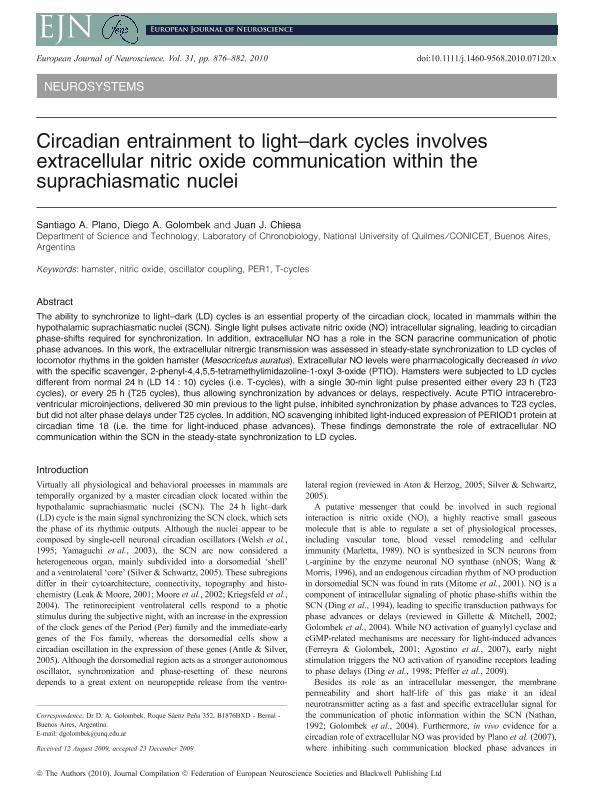Artículo
Circadian entrainment to light-dark cycles involves extracellular nitric oxide communication within the suprachiasmatic nuclei
Fecha de publicación:
03/2010
Editorial:
Wiley Blackwell Publishing, Inc
Revista:
European Journal Of Neuroscience
ISSN:
0953-816X
Idioma:
Inglés
Tipo de recurso:
Artículo publicado
Clasificación temática:
Resumen
The ability to synchronize to light-dark (LD) cycles is an essential property of the circadian clock, located in mammals within the hypothalamic suprachiasmatic nuclei (SCN). Single light pulses activate nitric oxide (NO) intracellular signaling, leading to circadian phase-shifts required for synchronization. In addition, extracellular NO has a role in the SCN paracrine communication of photic phase advances. In this work, the extracellular nitrergic transmission was assessed in steady-state synchronization to LD cycles of locomotor rhythms in the golden hamster (Mesocricetus auratus). Extracellular NO levels were pharmacologically decreased in vivo with the specific scavenger, 2-phenyl-4,4,5,5-tetramethylimidazoline-1-oxyl 3-oxide (PTIO). Hamsters were subjected to LD cycles different from normal 24 h (LD 14 : 10) cycles (i.e. T-cycles), with a single 30-min light pulse presented either every 23 h (T23 cycles), or every 25 h (T25 cycles), thus allowing synchronization by advances or delays, respectively. Acute PTIO intracerebroventricular microinjections, delivered 30 min previous to the light pulse, inhibited synchronization by phase advances to T23 cycles, but did not alter phase delays under T25 cycles. In addition, NO scavenging inhibited light-induced expression of PERIOD1 protein at circadian time 18 (i.e. the time for light-induced phase advances). These findings demonstrate the role of extracellular NO communication within the SCN in the steady-state synchronization to LD cycles.
Palabras clave:
Hamster
,
Nitric Oxide
,
Oscillator Coupling
,
Per1
,
T-Cycles
Archivos asociados
Licencia
Identificadores
Colecciones
Articulos(SEDE CENTRAL)
Articulos de SEDE CENTRAL
Articulos de SEDE CENTRAL
Citación
Plano, Santiago Andrés; Golombek, Diego Andrés; Chiesa, Juan José; Circadian entrainment to light-dark cycles involves extracellular nitric oxide communication within the suprachiasmatic nuclei; Wiley Blackwell Publishing, Inc; European Journal Of Neuroscience; 31; 5; 3-2010; 876-882
Compartir
Altmétricas




